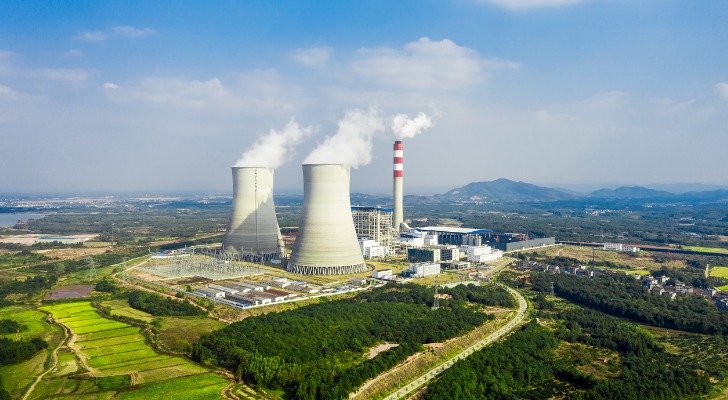Nuclear fusion may well be the technology of the future. If physicists can ever crack its secrets, fusion may be to the 21st century what coal was to the 19th and petroleum was to the 20th. This could become a new ubiquitous technology, a part of infrastructure found on every part of the globe. For investors, there’s enormous potential here. But, like with all investments, there are specific benefits and risks.
For help building a balanced investment portfolio, consider working with a financial advisor.
Nuclear Fusion Basics
Nuclear fusion energy is the idea of generating electricity from combining two atoms to create a new one. When two atoms fuse, the resulting atom has slightly less mass than the sum of its parts. This is due to the weak nuclear force, a form of mass/energy which binds subatomic particles together into atoms. Each atom has its own binding energy, so when two atoms are combined into a single entity this leftover binding energy is released as lost mass from the resulting atom. That generates the heat of a fusion reaction.
Fusion is the corollary to fission, the other currently understood source of nuclear energy. With fission, you create a reaction that splits a large atom into two smaller atoms. With fusion, you create a reaction that joins two smaller atoms into a larger one. Fission is rarely found in nature at large scale, but fusion is the power source for stars.
As a power source, fusion has many benefits over fission.
First, fusion is far safer than fission. Once you start a fission reaction, you must actively control it or it can flash consume all of its fuel in an explosive event. The hydrogen that fuels a fusion reaction, on the other hand, can be added as its consumed, meaning that the entire reaction will cease if you simply stop adding fuel. After a reaction, fission leaves behind highly toxic radioactive waste that can even be weaponized in the wrong hands. Fusion leaves behind helium, an inert and harmless gas that the world could actually use more of.
Fission is powered by relatively rare and expensive enriched uranium. Fusion is powered by an isotope of hydrogen, the most common element in the universe.
To top it all off, fusion generates more power than any other known process. With an equivalent amount of fuel, a fusion reactor can generate four times as much electricity as the fission reactors that current nuclear power plants use. That same fusion reactor can generate 4 million times as much energy as a chemical plant powered by coal or oil.
Fusion’s Problem
The basis behind a fusion reaction is what’s known as “the bottle.” It’s not currently possible to wrap up even tiny stars in a physical reactor. Any solid material would vaporize right away. Instead, the fusion reaction takes place inside a high-energy plasma. That plasma, in turn, is contained by a series of powerful magnetic fields. These shaped magnetic fields are called “the bottle.” The bottle contains and directs the heat of the fusion reaction, making it safe and productive.
The problem is that, with current technology, it takes more energy to sustain the magnetic bottle than the fusion reaction produces. The hotter you burn the reactor, the more energy it takes to keep the reaction contained. The result is energy-negative.
That’s changing however. Advances in several different fields, from mathematics to superconductors, are making it steadily more efficient to generate the magnetic bottle that contains and sustains a fusion reaction, and in 2022 the Lawrence Livermore National Laboratory made a credible claim to have generated a positive-sum reaction.
Two Way to Invest in Fusion

Investing in fusion is not easy. Since this is a developing technology, any investment in this field is fundamentally speculative. There are no publicly traded companies that operate fusion reactors, because no commercial fusion reactors exist yet. You can’t have an industry around a product that only exists as a very convincing theory.
That said, this is still a billion-dollar industry, with around $4.8 billion invested as of 2022. While much of that work is being done by government and university labs, there are several dozen private startup companies that are trying to develop their own reactors. Firms like Helion Energy and Commonwealth Fusion Systems have generated hundreds of millions in investment capital. Unfortunately for individual investors, they remain private companies. If you are an accredited investor, you can look for shares that someone might be willing to sell. Otherwise, it’s not currently possible to buy into a fusion company directly.
Instead, you have two major options.
Invest in Investors
First, you can invest in publicly traded companies that have themselves invested in fusion companies.
This is a technology that promises to fundamentally change the energy economy from the ground up, and the big players aren’t sitting that out. Major technology companies like Alphabet (GOOG) and Amazon (AMZN) have invested in fusion research companies. Lesser-known, but still large, firms like Babcock International (BCKIF) and Cenovus Energy (CVE) have done the same.
These companies have a significant stake in the companies that are trying to develop fusion technology. If those underlying investments pay off, the benefits will extend upward.
Other sources on this subject also recommend investing in firms that can benefit from the results of fusion, namely vast and cheap energy. If you want to do this, we recommend simply investing in the S&P 500. The reality is that virtually every company will benefit from these productivity gains and cost reductions. There’s no good way to pick a clear winner or loser, because all companies rely on energy-intensive resources.
Invest in Energy Companies
However advanced, fusion is still fundamentally an investment in the energy sector. The result is that investors looking to get into this market can do so by taking a long-term position in the energy sector.
You can do this by investing in specific energy source companies like Chevron (CVX). You can also invest in utilities that run power plants, like Duke (DUK) or National Grid (NGG). Or, you can invest in energy-sector funds. These would include mutual funds or ETFs like the Vanguard Energy ETF (VDE) or Global X Renewable Energy Producers (RNRG).
This is a long-term investment. Researchers are confident that fusion will become a viable, long-term energy source, one likely to significantly outlive fossil fuels. It’s not here yet though and, once it arrives, it probably will take quite a while to really take off. This is a good investment for your retirement portfolio, but probably not for the swimming pool fund.
Investing in Fusion Through Materials

Side-investing in nuclear fusion is another potentially good strategy.
Fusion relies on a handful of specialized resources to build its reactors and sustain its burn. The fuel source for fusion will be a mix of hydrogen isotopes called deuterium and tritium, although current experimental reactors only use deuterium. For the science-curious:
- Hydrogen atom. An atom with one proton and one electron
- Deuterium. An atom with one proton, one neutron and one electron
- Tritium. An atom with one proton, two neutrons and an electron
The heavier nuclei of deuterium and tritium make them easier to fuse and release more energy in the process. As an investor, you can seek out companies that produce deuterium gas (tritium is not yet produced in commercial quantities).
You can also seek out desalinization companies. Hydrogen isotopes are generally produced from water, by separating the molecule’s oxygen and hydrogen atoms from each other. To get enough water without wasting potable and agrarian supplies, producers will most likely rely on seawater production, which requires large scale desalinization.
Finally, you can seek out firms that make the components of a reactor itself. On this, we cannot offer specific advice because nobody knows what a working fusion reactor will be made of. Most likely, commercial fusion reactors will rely on superconducting materials to make the core of the electromagnets that contain the reaction. Companies that produce materials like mercury, titanium, niobium alloys, and next-generation ceramics are all good candidates as long-term suppliers for a fusion reactor’s core.
How to Assess Nuclear Fusion Investments and Risks
If you want to assess investment opportunities in nuclear fusion, start by researching key players in the field, including startups and established companies. As with other investments, look at their funding, technological advancements and the scale of their projects to gauge potential profitability. Since nuclear fusion is in its early stages, these investments generally involve high risk and require a long-term commitment.
It’s also important to understand the risks involved. Technical challenges, such as the industry’s current inability to produce more energy than it consumes, are significant. Additionally, the extended timelines for research and development can delay returns and impact the liquidity of your investments.
Finally, keep up with nuclear fusion developments by following news from leading projects and institutions. Regulatory changes, technological breakthroughs and new funding can all significantly influence the viability of fusion investments. Attending industry conferences and consulting with experts can also offer deeper insights, helping you make informed decisions in this emerging field.
Bottom Line
Investing in fusion may be one of the most solid bets anybody can make on long-term investments in the future. You can do so by investing in companies that are trying to build their own reactors, by investing in the energy sector or by investing in the companies that will someday fuel these reactors.
Energy Investment Tips
- A financial advisor can help you build an investment portfolio that includes fusion investments. SmartAsset’s free tool matches you with vetted financial advisors who serve your area, and you can have a free introductory call with your advisor matches to decide which one you feel is right for you. If you’re ready to find an advisor who can help you achieve your financial goals, get started now.
- Fusion is the big dream of next-generation energy. Before physicists crack that puzzle, though, there are many ways you can invest in next-generation energy right now.
Photo credit: ©iStock.com/mesh cube, ©iStock.com/WangAnQi, ©iStock.com/Farknot_Architect
